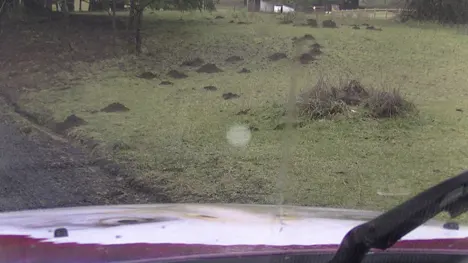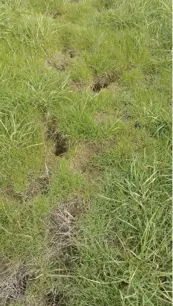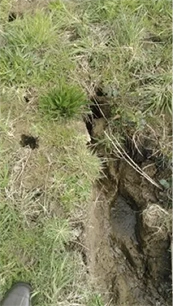Got Questions? We've Got Answers.
Frequently Asked Questions
Q: How Can I Determine If My Property Has A Gopher Or Mole Pest Problem?
A: Identifying signs of a gopher or mole infestation is crucial for effective pest control.
Look for mounds of fresh soil, as they are the primary indication of a gopher's presence. Gophers create crescent-shaped mounds as they dig tunnels and push loose dirt to the surface.
On the other hand, moles form more circular mounds. Additionally, moles commonly burrow just beneath the surface, leaving a raised ridge to mark their path, unlike gophers.
Q: How do I know my property has a Gopher or Mole pest problem?
A: Identifying a gopher or mole infestation often begins with the observation of mounds of fresh soil as this is the most obvious sign of a infestation. Gophers, in particular, create crescent-shaped mounds as they excavate tunnels and push loose dirt to the surface. Conversely, mole mounds are more circular in appearance, which can sometimes be mistaken for gopher mounds. Additionally, while gophers create visible mounds, moles typically burrow just beneath the surface, leaving a raised ridge as they navigate through your property.
Some common signs of mole & gopher activity:
- Tunneling: Look for visible tunnels or ridges in your yard, especially in areas with soft, moist soil.
- Damage to Plant Roots: Mole and gopher activity can lead to damage to the roots of plants, shrubs, and trees, causing wilting or stunted growth.
- Visible Surface Runways: Moles may create shallow surface runways as they move between feeding areas, which can appear as raised ridges or depressions in the soil.
- Visible Feeding Holes: Look for small, round holes in the ground where moles or gophers have accessed the soil to feed on insects, roots, or plant bulbs. Open holes slightly larger than a quarter are usually voles.
Q: Is Gopher Patrol A Licensed And Reputable Pest Control Company In Oregon?
A: Absolutely. Gopher Patrol is fully licensed, bonded, and insured in the state of Oregon, ensuring compliance with industry standards and regulations. Our commitment to professionalism and excellence is reflected in our high ratings and recommendations from local landscapers and pest control companies. Click Here to see our reviews and read what customers have to say about our work.
Additionally, you can click the image below to look up our CCB for extra peace of mind.

Q: What Methods Does Gopher Patrol Use For Mole And Gopher Control?
A: At Gopher Patrol, we deploy a strategic approach to mole and gopher removal, utilizing traps tailored to specific tunnel systems. By checking for fresh feeding locations near pest holes and employing proven techniques, we effectively target and eliminate mole and gopher populations, ensuring long-term pest control solutions for our clients. This targeted trapping approach guarantees efficient and humane removal from your property.
Q: Why Are Traps The Preferred Method For Removing Moles And Gophers?
A: Trapping continues to be the most effective method found to get rid of moles and gophers to date. Other methods have proven over many decades to be ineffective in removing moles and gophers. Don't be misled by ineffective approaches such as repellents, sonic deterrents, toxic fumes, explosions or some other form of futile attempt. Our team sets traps out aggressively to achieve speedy and effective results you can count on.

Smoke Bombs and gases face challenges in effectively reaching the target animal. Unlike solid traps, gases have limited mobility and may struggle to penetrate deeply into the tunnel system. Pressurized gases can be somewhat effective in certain conditions, such as in dry climates where tunnels can hold pressure. However, in the wetter ground of the Willamette Valley, with permeable mud and loose soil, pressurization becomes impractical and ineffective for gopher control.
Using poison pellets or worms to control moles and gophers is often ineffective and can be considered a lost cause. This is due to the abundance of natural food sources available to these pests in Oregon. Moles and gophers select their habitat based on their dietary preferences and nutritional needs, much like a donkey would prefer fresh apples over straw. Therefore, relying on poison as a means of control is akin to offering an unappealing option when abundant, natural food sources are readily available.
Explosions pose significant hazards and dangers, making them impractical for mole and gopher control. Most insurance policies do not cover damages resulting from explosions, underscoring the inherent risks involved. Additionally, achieving successful results with explosives relies on ideal conditions, such as dry ground and vegetation to contain explosive gas prior to ignition. However, these conditions also increase the risk of dangerous fires. Moreover, even in optimal circumstances, there's no guarantee of complete effectiveness, potentially leaving the problem unresolved.
While pesticides are occasionally used to target the food sources, this approach is often a short-term and costly endeavor. This approach also can create unwanted havoc on an otherwise healthy lawn. Additionally, the pesticides might only be a temporary fix, as the pests are likely to return after the chemicals wear off. Just as your yard will recover and return from the chemical procedure, the pests will do the same. At Gopher Patrol, we prioritize environmentally friendly pest control methods over unnecessary chemical applications. In cases where pesticides have been previously used, we employ strategic trapping methods to capture moles effectively.
Our current technology's best option is still the classic trap. We invest around $10-20k per year in customized traps made in the USA to handle mole and gopher problems with maximum efficiency and effectiveness. These traps are crafted to address mole and gopher issues with precision and ethical standards. While advancements such as robotic solutions may emerge in the future, trapping remains our primary method for the foreseeable future because of their proven track record.
Q: Are the mole/gopher traps safe for my pets?
A: Our steel traps have never caught a pet or any livestock. While some trap styles may have an exposed portion, it's harmless as the active end is deep underground, targeting moles/gophers.
Gophers can be enticing to carnivores and omnivores, and dogs may dig up a trap containing a gopher out of curiosity. However, once the trap is sprung, it's inert and poses no danger.
Q: How often do you check the mole and gopher traps?
A: We conduct trap monitoring on a weekly basis. If mole and gopher activity indicates rapid tunneling, we increase the frequency of checks to promptly address the issue. Unlike many other companies that may overbook or fail to deliver timely service, we prioritize resolving pest problems efficiently without leaving any customer behind.
Q: When do moles and gophers have their offspring?
A: Pocket gophers typically give birth in spring, although under favorable conditions, they may reproduce throughout the year. Properties at elevations exceeding 500 feet often experience a higher incidence of a second or even third run of pups.
Moles typically have their offspring in mid to late winter. This timeframe can give them an advantage, as signs of activity are first noticed when we get back on top of our Spring/Summer landscaping. Once mole activity becomes evident, homeowners face limited options: either wait in hope for the problem to resolve itself or enlist our services to effectively eliminate moles and reclaim their yard.
Q: How do I know what made this hole or mound?
A: Identifying the culprit behind a hole or mound is essential for effective pest management. Heavy mole mounds, evenly spread across the landscape, often indicate the presence of moles. These mounds, typically the work of 1-3 moles in a matter of days, are distinctive in appearance.




Q: Does Gopher Patrol deal with Voles?
A: At Gopher Patrol, we focus on providing expert solutions for gophers and moles to safeguard your property. Please note that we do not handle voles. Vole control poses challenges in measuring effectiveness and often involves methods using poisons, which we avoid for environmentally friendly practices.
Q: When are gophers and moles known to be active?
A: Gophers and moles are active year-round, although their activity may not always be visibly apparent. Gophers, in particular, can be active at all hours of the day as they construct tunnels and forage for food. Similarly, moles maintain their activity levels throughout the year. Younger gophers and moles may show minimal signs of activity initially, as they continue living in existing holes. However, as they grow they are forced to excavate accumulating mud/dirt in the tunnels. It's essential to address mole and gopher problems promptly, as they almost never resolve on their own and can escalate into "Mole Madness" with significant issues if left unattended.
Q: What are some more tools you use?
A:
Get in Touch!
We'd love to hear from you. You can either reach out to us as a whole and one of our awesome team members will get back to you, or if you have a specific question reach out to one of our staff.
503•487•6895 AlexGopherPatrol@Gmail.com
PO Box 3042 Newberg, OR 97132